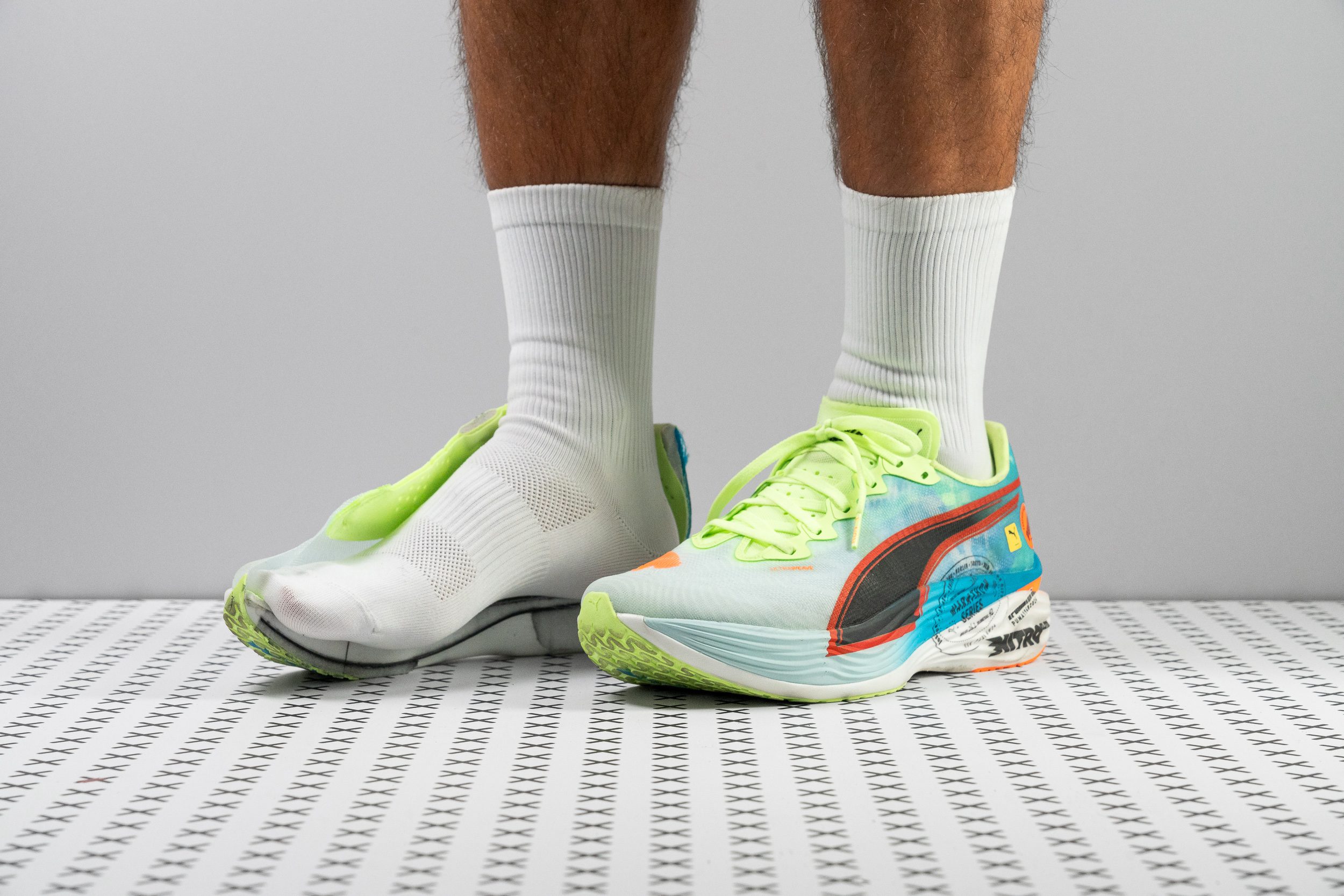Our verdict
- Top pick in best marathon running shoes
- Top pick in best half marathon running shoes
Pros
- Superb Nitro Elite foam
- Breathable, lightweight upper
- Extremely responsive
- More affordable than most supershoes
- Outstanding grip
- Great comfort for a racer
- Major improvements from v2
- Fast, agile, race-ready performance
- Fantastic tongue
Cons
- Not the best for heel strikers
- Durability concerns
- Lacks stability for some runners
Audience verdict
- Top 13% in road running shoes
- Top 29% in PUMA running shoes
- Top 14% most popular running shoes
Comparison
The most similar running shoes compared
+ + Add a shoe | |||||
|---|---|---|---|---|---|
| Audience score | 90 Superb! | 88 Great! | 89 Great! | 88 Great! | |
| Price | £195 | £230 | £150 | £285 | |
| Pace | CompetitionTempo | Competition | Tempo | Competition | |
| Shock absorption | High | High | High | High | |
| Energy return | High | High | Moderate | High | |
| Traction | High | High | High | Moderate | |
| Arch support | Neutral | Neutral | Neutral | Neutral | |
| Weight lab Weight brand | 7.2 oz / 204g 7.4 oz / 209g | 7.8 oz / 220g 7.7 oz / 218g | 9.5 oz / 268g 9.5 oz / 269g | 7.1 oz / 201g 7 oz / 198g | |
| Lightweight | ✓ | ✓ | ✗ | ✓ | |
| Drop lab Drop brand | 10.6 mm 8.0 mm | 9.5 mm 8.0 mm | 10.1 mm 10.0 mm | 8.5 mm 8.0 mm | |
| Strike pattern | Heel | HeelMid/forefoot | Heel | HeelMid/forefoot | |
| Size | True to size | True to size | Slightly small | Slightly small | |
| Midsole softness | Soft | Balanced | Soft | Soft | |
| Difference in midsole softness in cold | Normal | Small | Normal | Small | |
| Toebox durability | Bad | Good | Decent | Bad | |
| Heel padding durability | Good | Good | Decent | Good | |
| Outsole durability | Decent | Good | Decent | Bad | |
| Breathability | Moderate | Breathable | Moderate | Breathable | |
| Width / fit | Medium | Medium | Narrow | Medium | |
| Toebox width | Narrow | Medium | Narrow | Medium | |
| Stiffness | Stiff | Stiff | Stiff | Stiff | |
| Torsional rigidity | Stiff | Stiff | Stiff | Stiff | |
| Heel counter stiffness | Flexible | Flexible | Flexible | Flexible | |
| Plate | Carbon plate | Carbon plate | Carbon plate | Carbon plate | |
| Rocker | ✓ | ✓ | ✗ | ✓ | |
| Heel lab Heel brand | 39.2 mm 40.0 mm | 38.1 mm 40.0 mm | 37.4 mm 39.0 mm | 38.1 mm 40.0 mm | |
| Forefoot lab Forefoot brand | 28.6 mm 32.0 mm | 28.6 mm 32.0 mm | 27.3 mm 29.0 mm | 29.6 mm 32.0 mm | |
| Widths available | Normal | Normal | NormalWide | Normal | |
| Orthotic friendly | ✓ | ✓ | ✓ | ✗ | |
| Season | All seasons | SummerAll seasons | All seasons | SummerAll seasons | |
| Removable insole | ✓ | ✓ | ✓ | ✗ | |
| Ranking | #39 Top 11% | #146 Top 39% | #117 Top 32% | #136 Top 37% | |
| Popularity | #49 Top 14% | #33 Top 9% | #55 Top 15% | #23 Top 7% |
Who should buy
We believe the Puma Deviate Nitro Elite 3 excels for:
- Runners seeking a nimble, race-ready super shoe that tackles distances from the mile to the marathon.
- Those who found the previous Deviate Nitro Elite lacking excitement—Puma fixed that, making it a thrilling ride.
- Midfoot strikers looking for a high drop super shoe with outstanding performance and superb energy return.
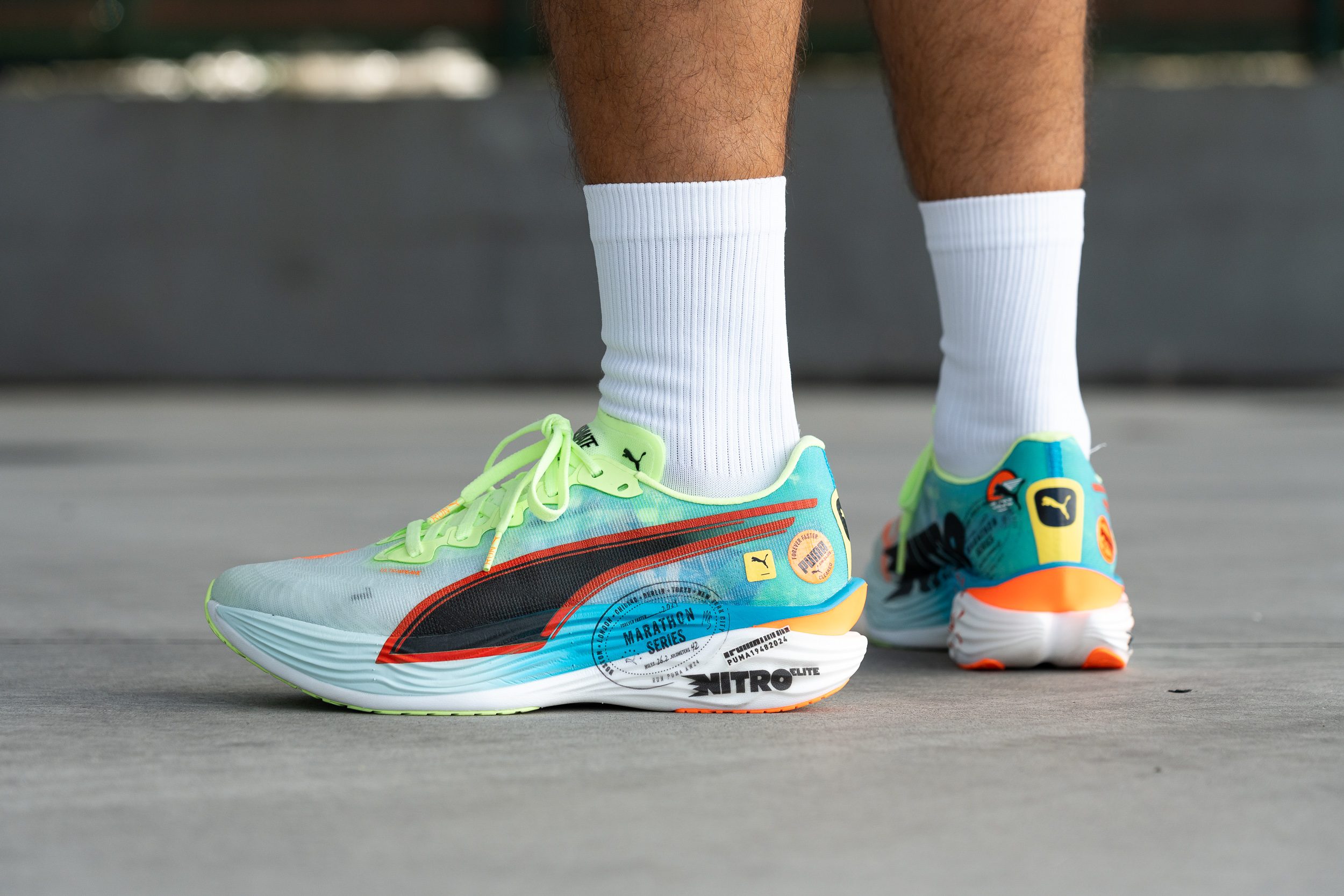
Who should NOT buy
We believe the Deviate Nitro Elite 3's lack of stability might be a dealbreaker for some. Its narrow build brings excitement and speed, but it’s not ideal for everyone. In our view, if stability is what you're after, the Nike Alphafly 3 or Adidas Adizero Adios Pro 3 are far more stable, marathon-suited options, while still offering comparable speed.
Additionally, we think that forefoot strikers may struggle with the high heel-to-toe drop of the Deviate Nitro Elite 3. If that’s a concern, we suggest the ASICS Metaspeed Sky Paris as a better alternative or the Rocket X 2 for those who prefer Hoka's signature feel.
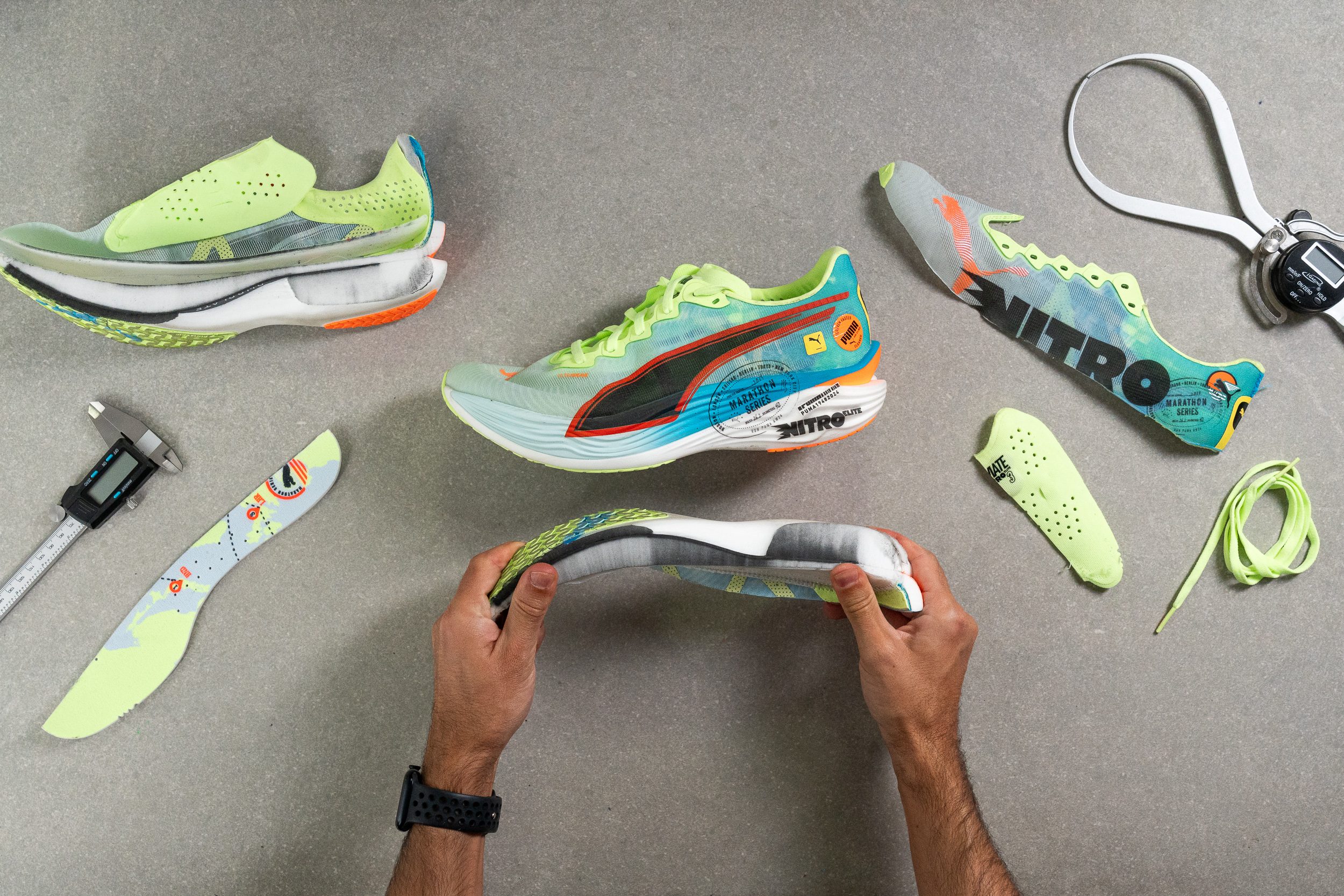
Cushioning
Shock absorption
We found that the Deviate Nitro Elite 3 delivers muscle-friendly shock absorption with a staggering 147 SA in the heel. The forefoot also impressed us at 127 SA.
In our view, Puma clearly aimed to build a marathon-ready, joint-protecting super shoe—and judging by these numbers, they absolutely hit the mark.
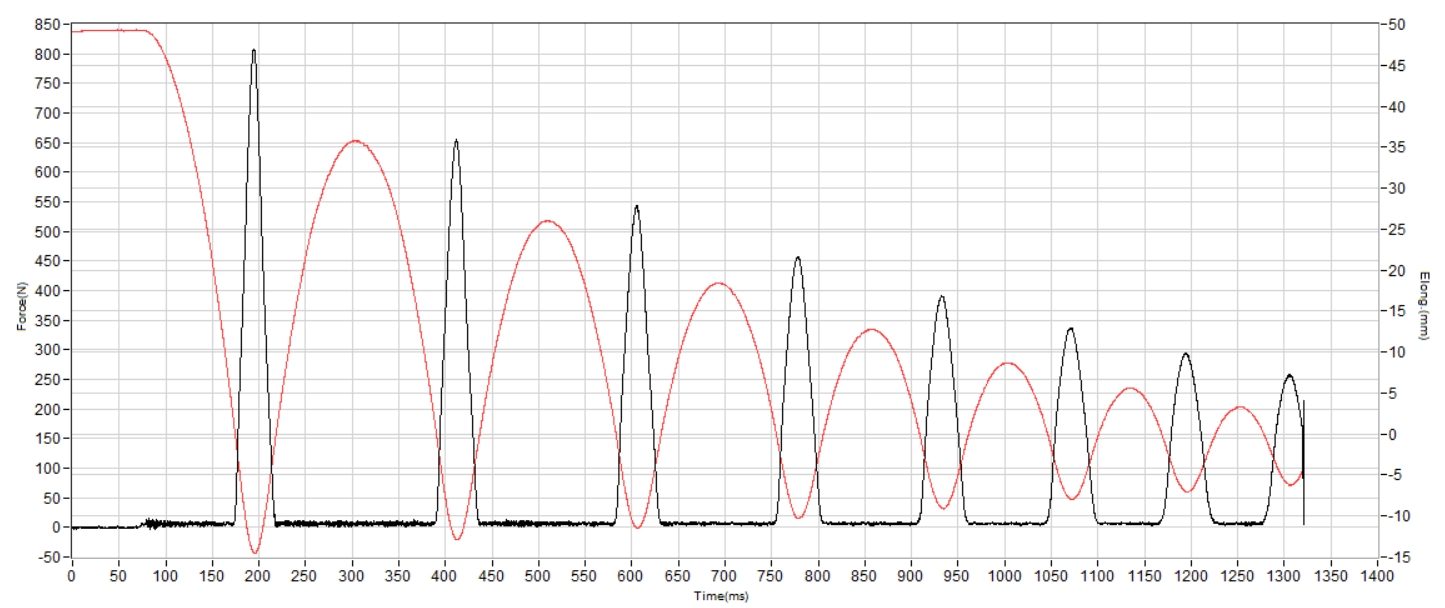
| Deviate Nitro Elite 3 | 147 SA |
| Average | 129 SA |
Energy return
This shoe features the latest version of Nitro Elite foam, now made from A-TPU instead of PEBA. That’s the current cutting-edge formula for speed, and it proved its worth in our lab with a strong 77.1% energy return that outperforms the Nike Vaporfly and Alphafly. While faster models will emerge soon, very few shoes today can trim seconds like this one.
| Deviate Nitro Elite 3 | 77.1% |
| Average | 58.5% |
Heel stack
Speaking of pushing boundaries, Puma has met the current challenge to every super shoe manufacturer by maximising the stack height near the 40-mm limit set by World Athletics. They achieved it with 39.2 mm of plush cushioning in the heel.
And don't worry, we'll also delve into the state-of-the-art Nitro Elite foam. But let us tell you that it provides exceptional cushioning, and as many midfoot strikers involuntarily shift to heel landings after mile 20 in a marathon due to fatigue, this towering 39.2-mm stack height in the heel offers a crucial advantage.
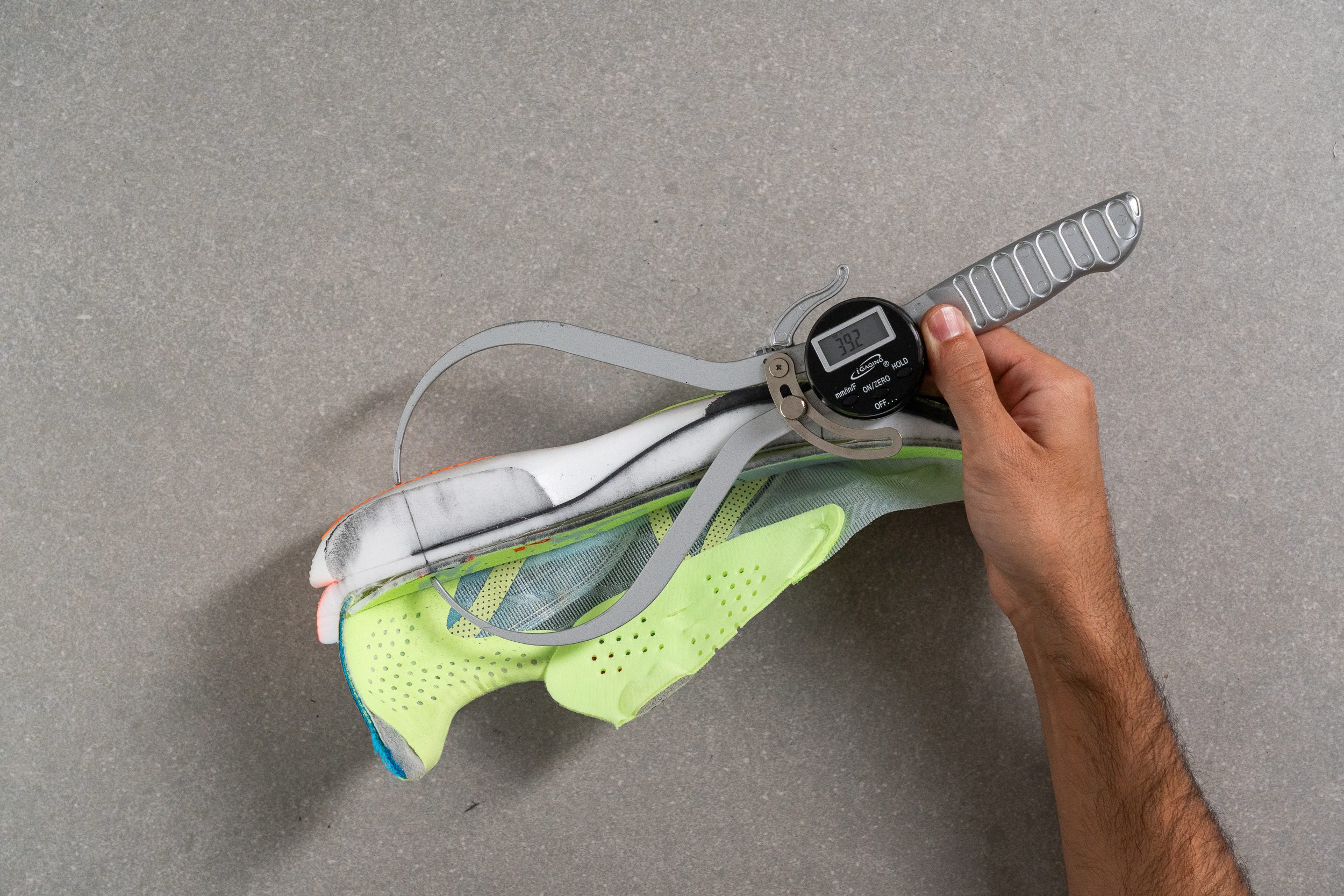
| Deviate Nitro Elite 3 | 39.2 mm |
| Average | 34.8 mm |
Forefoot stack
In our lab, the forefoot measured at 28.6 mm, typical for most super shoes and adequate for forefoot strikers, though slightly thinner than expected. And this reading introduces a minor issue that we will explore next.
By the way, the carbon plate isn't as thick as it appears. During the process of cutting the shoe in half, the foam can sometimes turn black from the debris.
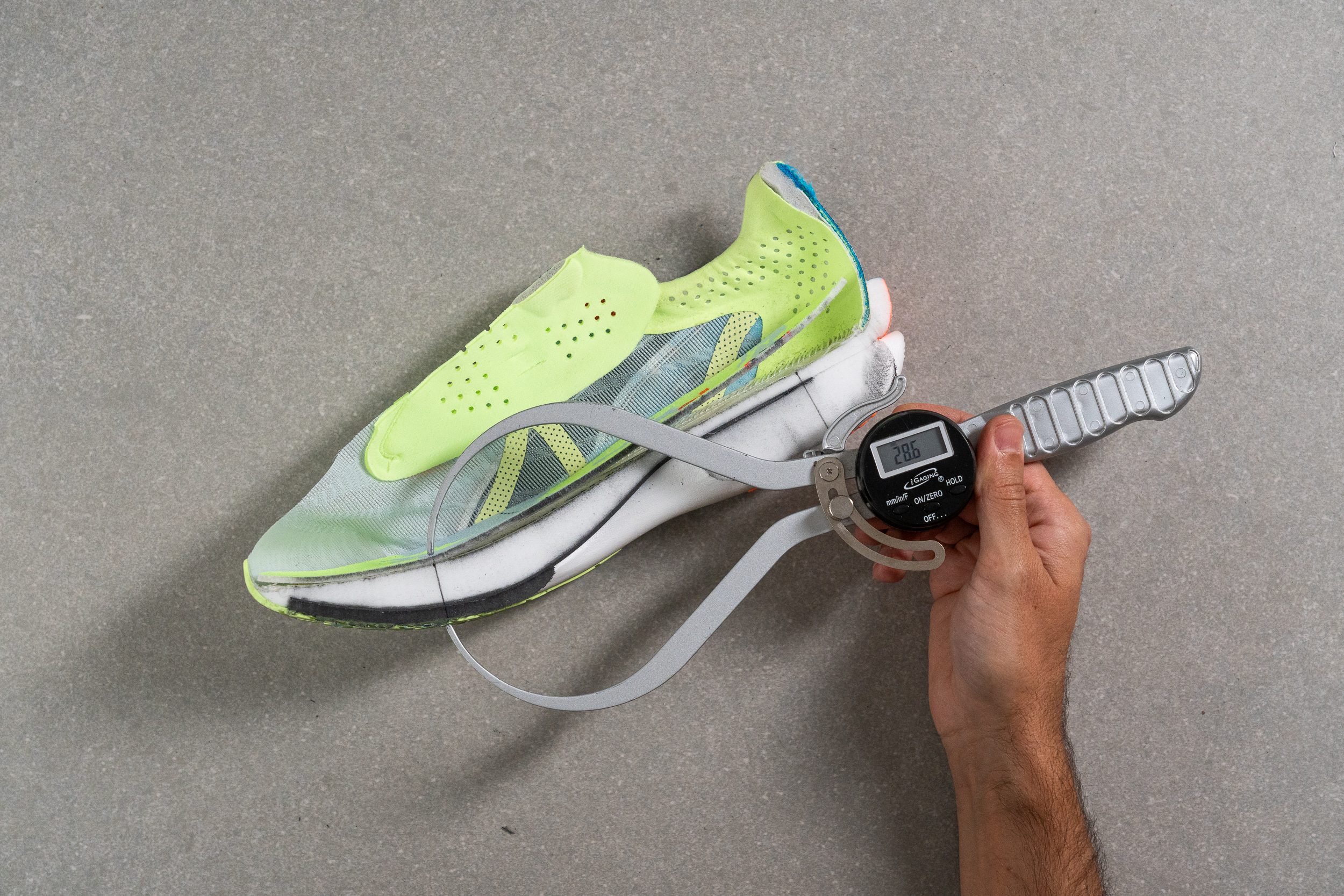
| Deviate Nitro Elite 3 | 28.6 mm |
| Average | 26.2 mm |
Drop
After our measurements, we discovered a 10.6-mm heel-to-toe drop, which is slightly higher than preferred.
Although this is beneficial for those with calf or Achilles tendon issues, the shoe's narrow rearfoot makes it less suitable for heel strikers. We would have favoured an 8-mm drop as advertised, though the actual difference of 2.6 mm is relatively minor anyway.

| Deviate Nitro Elite 3 | 10.6 mm |
| Average | 8.6 mm |
Midsole softness
The most notable upgrade in the Deviate Nitro Elite 3 over its predecessor might go unnoticed, but we're here to ensure that's not happening. Although it retains the Nitro Elite name, this is a whole different compound.
Puma has switched from a supercritical PEBA mix to an industry-first aliphatic TPU foam, enhancing durability and UV resistance. This change significantly boosts performance in the later stages of a marathon by reducing foam fatigue and extends the shoe's shelf life.
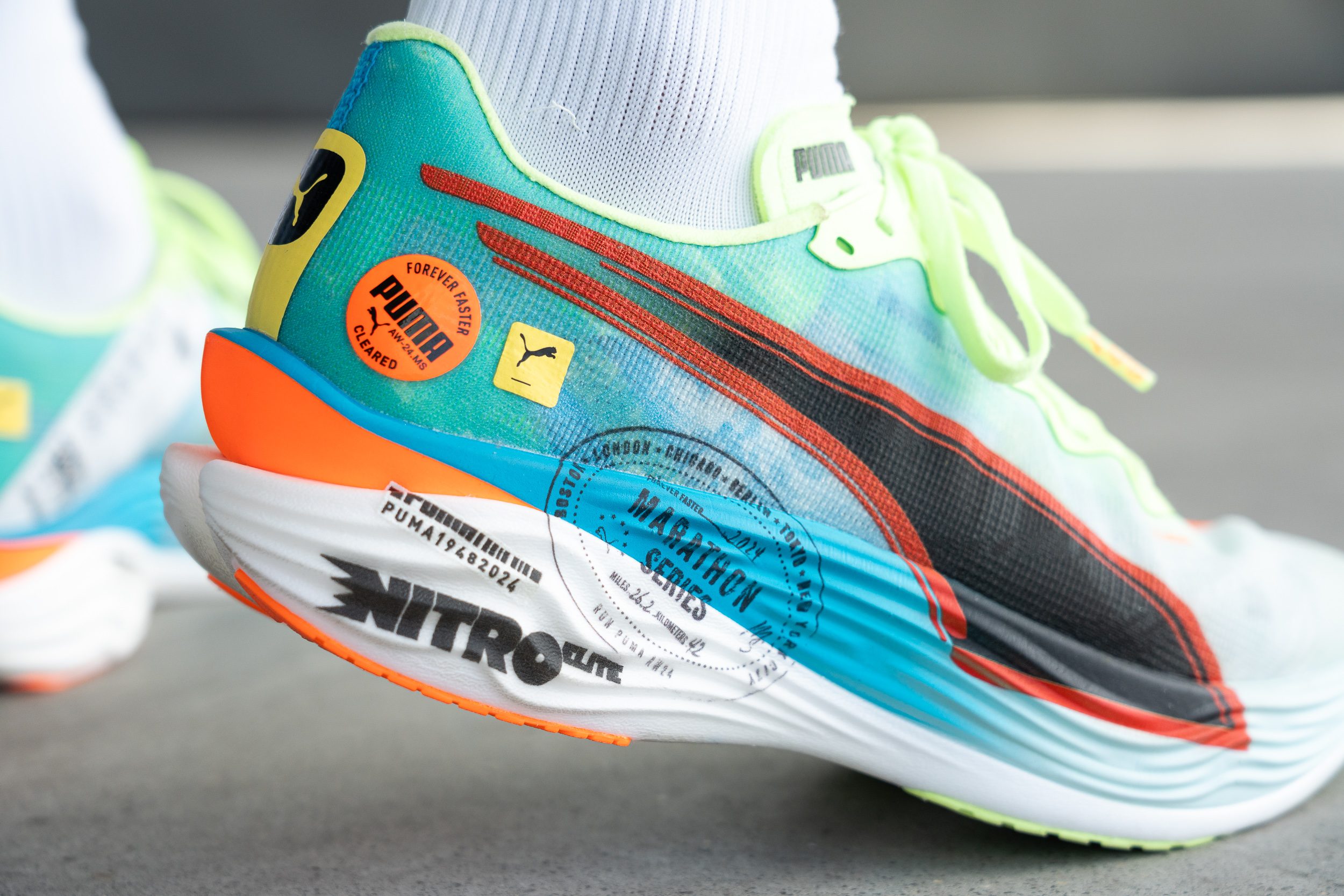
The main foam in the shoe is exceptionally soft, registering at 15.1 HA on our durometer. Puma strategically layers two different foam densities around a stiff carbon plate, a setup reminiscent of the popular Vaporfly design that many brands have followed since 2017.
Regarding energy return, we found that this foam performs on par with leading PEBA-based materials such as ZoomX or PWRRUN HG. And yes, the shoe consistently delivered exceptional bounce back during our runs, particularly at faster paces.

| Deviate Nitro Elite 3 | 15.1 HA |
| Average | 20.4 HA |
Secondary foam softness
As previously mentioned, Puma incorporates two different Nitro Elite foams in this shoe, one softer than the other.

The secondary foam, positioned closer to the ground and below the carbon plate, is slightly firmer and denser, measured at 18.3 HA. This is clearly geared towards enhancing stability, but with a minimal difference of 3.2 HA, is subtle and mostly indiscernible outside of our lab.

| Deviate Nitro Elite 3 | 18.3 HA |
| Average | 22.8 HA |
Rocker
While the Deviate Nitro Elite 3 introduces notable changes from its predecessor, such as updated foam and a redesigned carbon plate, certain features remain unchanged, including the rocker profile.
Our measurements confirm that the forefoot rocker of the DNE3 maintains the exact shape of its predecessor, beginning at 10 cm and rising to 5 cm, indicating no changes were necessary as the toe-off remains effective and fast.
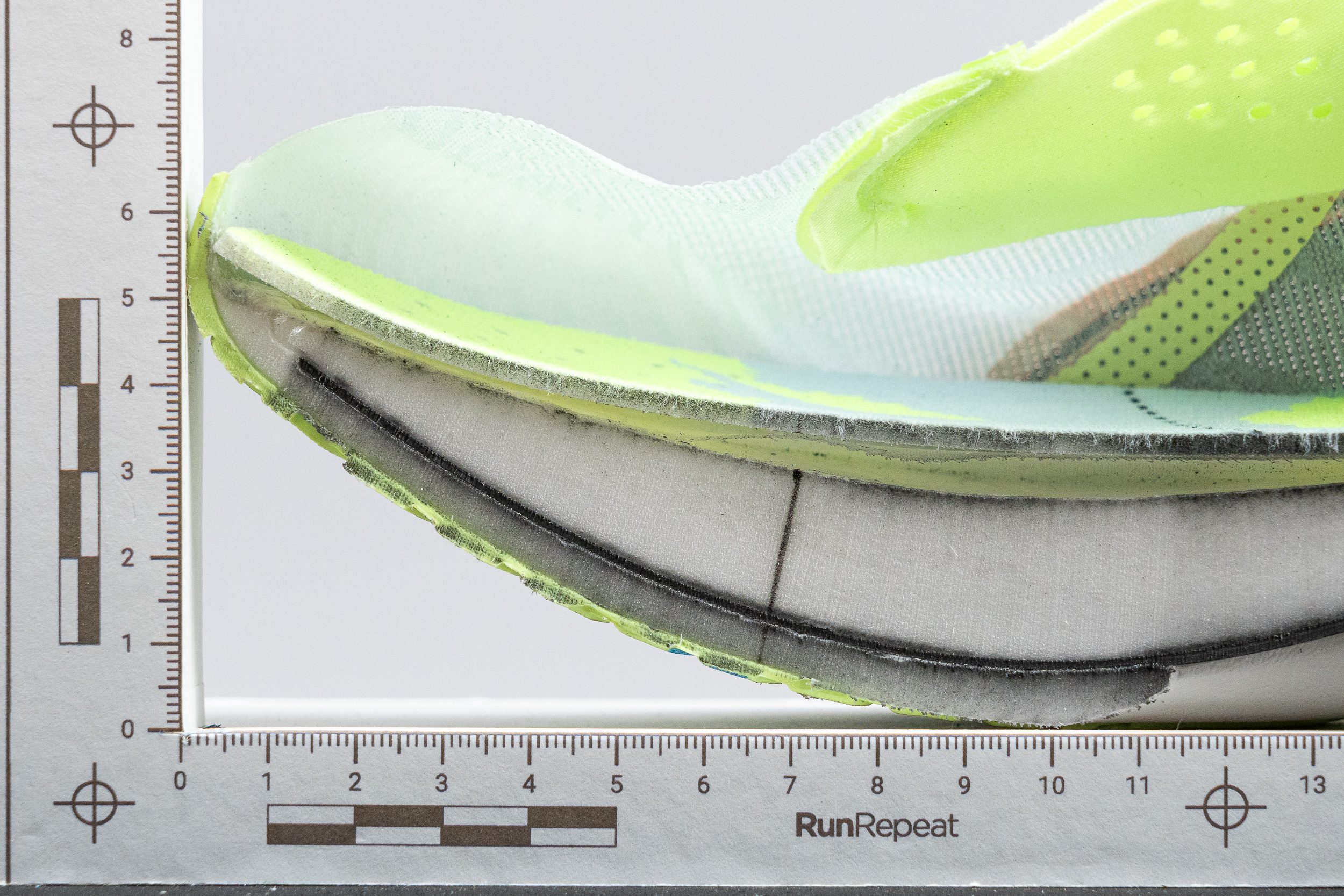
Plate
Puma has reengineered the carbon PWRPLATE to be more aggressive compared to previous models and its training partner, the Deviate Nitro 3. And why not—let's use this opportunity to discuss and compare carbon plates.
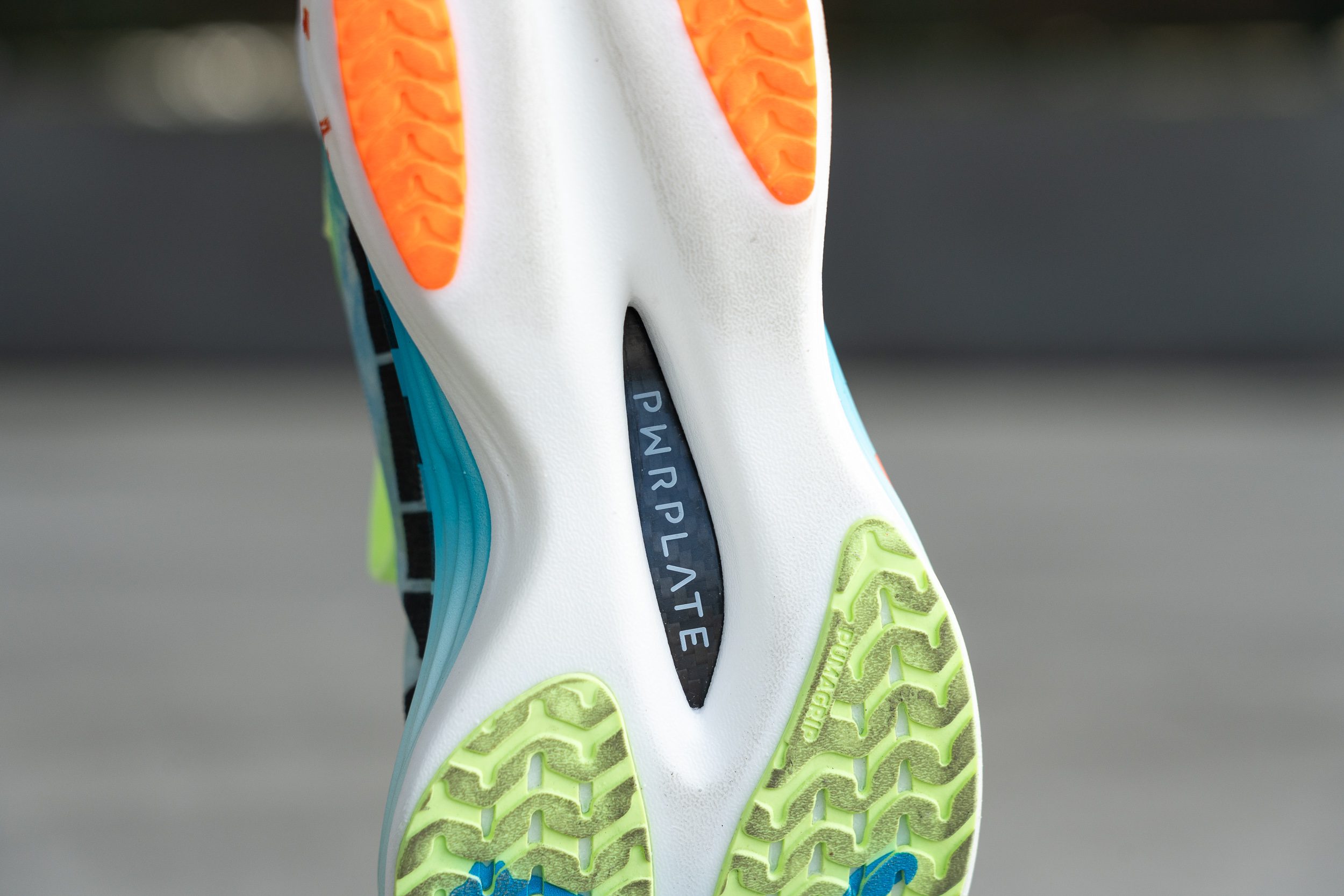
First, we put the Deviate Nitro Elite 3 (green) against its training sibling, the Deviate Nitro 3 (orange). It's evident the DNE3 has a much more aggressive curve starting after the heel and more sharply in the forefoot, aiming to boost turnover. This design is more demanding on the muscles—especially calves—but quicker, making sense of both approaches.

Then, we compared the Deviate Nitro Elite 2 (black and green) with the Deviate Nitro Elite 3 (green). It's evident Puma aimed to make the DNE3 more Vaporfly-esque and aggressive. This design enhances speed, and although it may reduce versatility when compared to v2, it excels at helping everyone achieve personal bests!

Size and fit
Size
PUMA Deviate Nitro Elite 3 fits true to size (97 votes).
Internal length
| Deviate Nitro Elite 3 | 264.9 mm |
| Average | 269.5 mm |
Width / Fit
We believe the best way to measure the fit is by transferring all the empty space into a gel mould and measuring it precisely. Using this method, we found the Deviate Nitro Elite 3 offers decent room at 94.4 mm, making it far from a narrow shoe compared to other Puma running models.
However, there’s a catch, and you may have guessed it by examining the shape of the mould. Yes, the toebox features an ultra-tapered design!
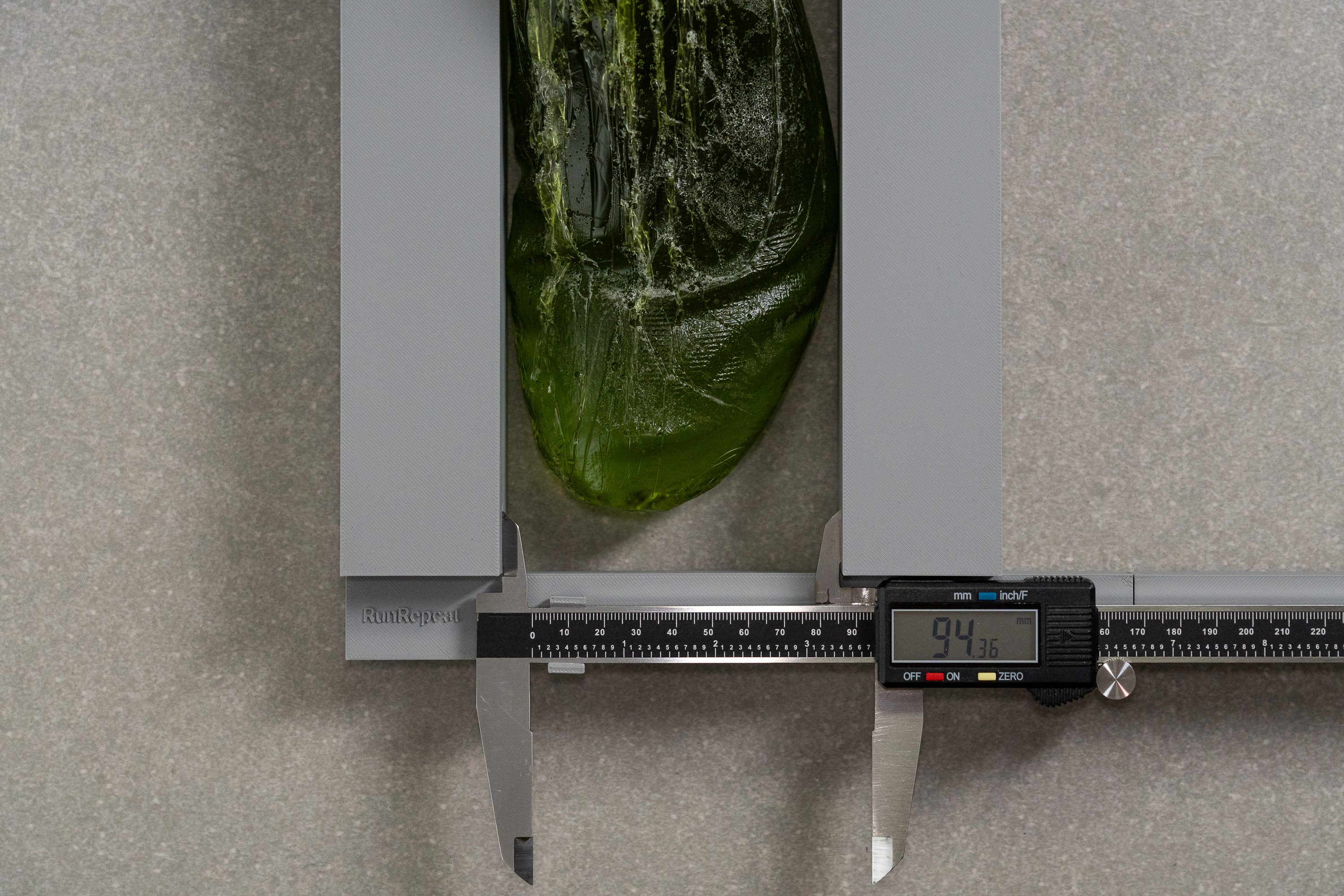
| Deviate Nitro Elite 3 | 94.4 mm |
| Average | 95.1 mm |
Toebox width
The big toe area is really narrow, measuring just 69.5 mm, creating a sharp profile that could pose issues for some runners during the later stages of a marathon.

We believe this shoe is best suited for slim-footed runners or those with average feet who don’t require much toe splay.
| Deviate Nitro Elite 3 | 69.5 mm |
| Average | 73.2 mm |
Toebox height
In terms of height, we measured 26.5 mm—a solid result for a super shoe. It provides a snug yet comfortable fit, striking a balance that’s ideal for racing.

| Deviate Nitro Elite 3 | 26.5 mm |
| Average | 27.1 mm |
Traction / Grip
Traction test
If you're after a super shoe with standout grip, the Deviate Nitro Elite 3 is tough to top. It scored an impressive 0.67 in our test—delivering race-ready traction even when the road turns slick from a surprise downpour.
| Deviate Nitro Elite 3 | 0.67 |
| Average | 0.48 |
Outsole design
PumaGrip keeps raising the bar, and we think it’s good enough to rival Continental as one of the best rubbers in road running shoes. We also found solid coverage for a super shoe, especially in the forefoot, where the large lime-green section delivers grippy traction. On the flip side, heel strikers may find the two orange pods a bit small.

Flexibility / Stiffness
The Elite 3 demonstrated a moderate 18.1N in our 30-degree bend test, which is lower than usual for a shoe with a carbon plate. This makes the Deviate Nitro 3 a stronger pick for moderate paces or long training runs compared to other super shoes.

| Deviate Nitro Elite 3 | 18.1N |
| Average | 15.3N |
Stiffness in cold (%)
Following a 20-minute nap in the freezer, we re-evaluated the shoe's stiffness and recorded a slight increase to 52.2N of force—a mere 1.5% surge. This minor change is barely perceptible, even in the coldest conditions.
| Deviate Nitro Elite 3 | 2% |
| Average | 33% |
Weight
Historically, the weight of the Deviate Nitro series has been a drawback compared to state-of-the-art super shoes like the Nike Vaporfly 3, with Puma facing challenges in achieving ultra-lightweight designs.
However, our scale now shows a nice figure of just 7.2 oz or 204g, marking a significant improvement from previous models. For us, this weight is highly competitive and should satisfy most runners, though we believe Puma could still benefit from reducing it to below 7 ounces to keep up with industry advancements—most brands are really pushing the boundaries!
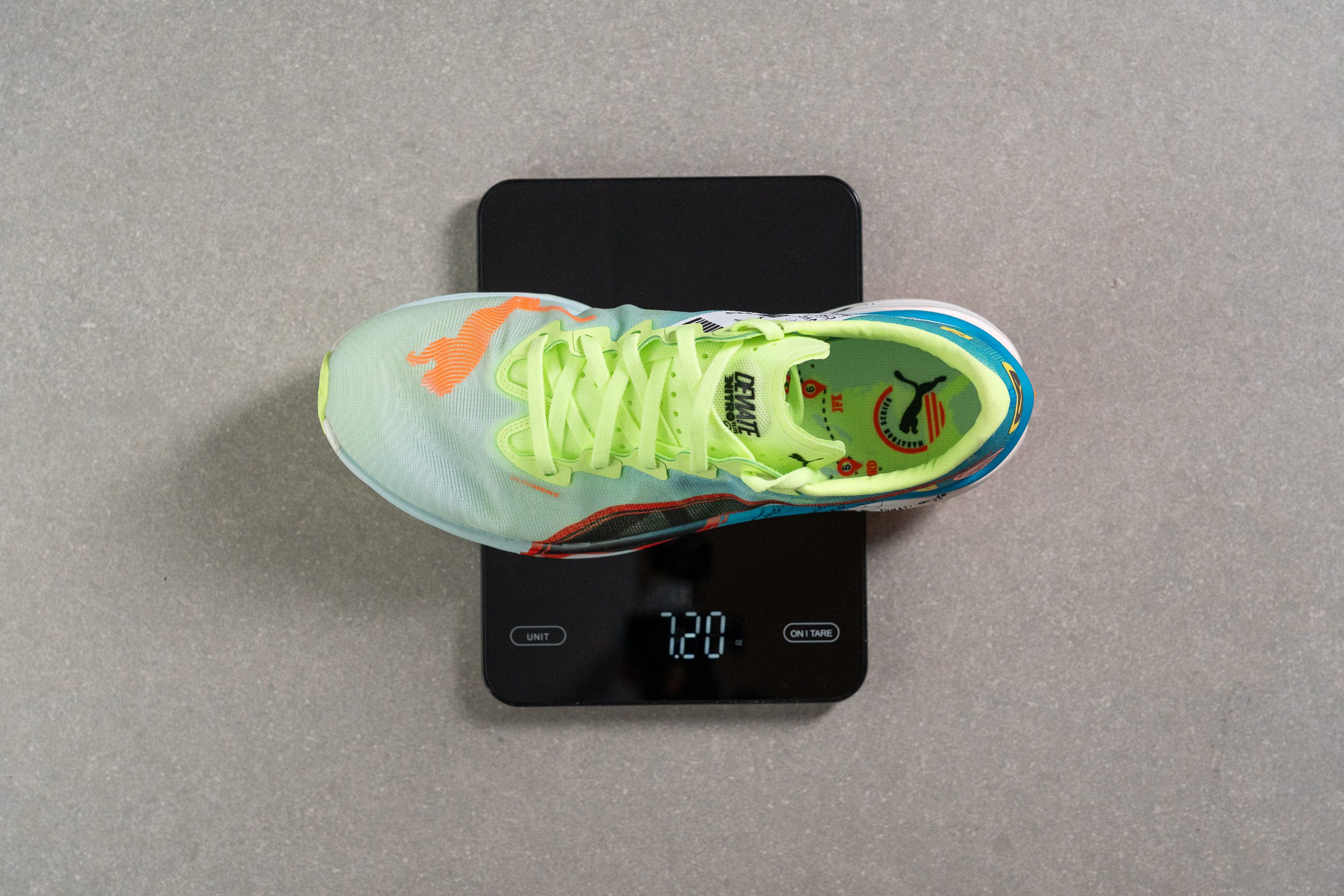
| Deviate Nitro Elite 3 | 7.2 oz (204g) |
| Average | 9.3 oz (264g) |
Breathability
To begin our lab test of the Deviate Nitro Elite 3, we examined its ventilation, which looks promising due to the Ultraweave engineered mesh upper, which is as thin as a razor.
Using our smoke machine, we discovered that the toebox expels air at a solid pace, though it doesn't match the breathability of other super shoes we've tested. Consequently, we gave it a solid 4/5, which we think it's sufficient to handle even the hottest races.
Next, we moved the cut-in-half DNE3 over a powerful light to highlight its construction and the minimalistic thickness. Puma enhanced stability with its logo and included PWRTAPE reinforcements, a common feature in their shoes.

While monomesh uppers generally impress under the microscope, the Deviate Nitro Elite 3 was particularly striking. The threads are incredibly thin and display remarkable precision.

The Nitro Elite 3 integrates a few thermoplastics in the upper, but they are not intrusive or noticeable by any means.
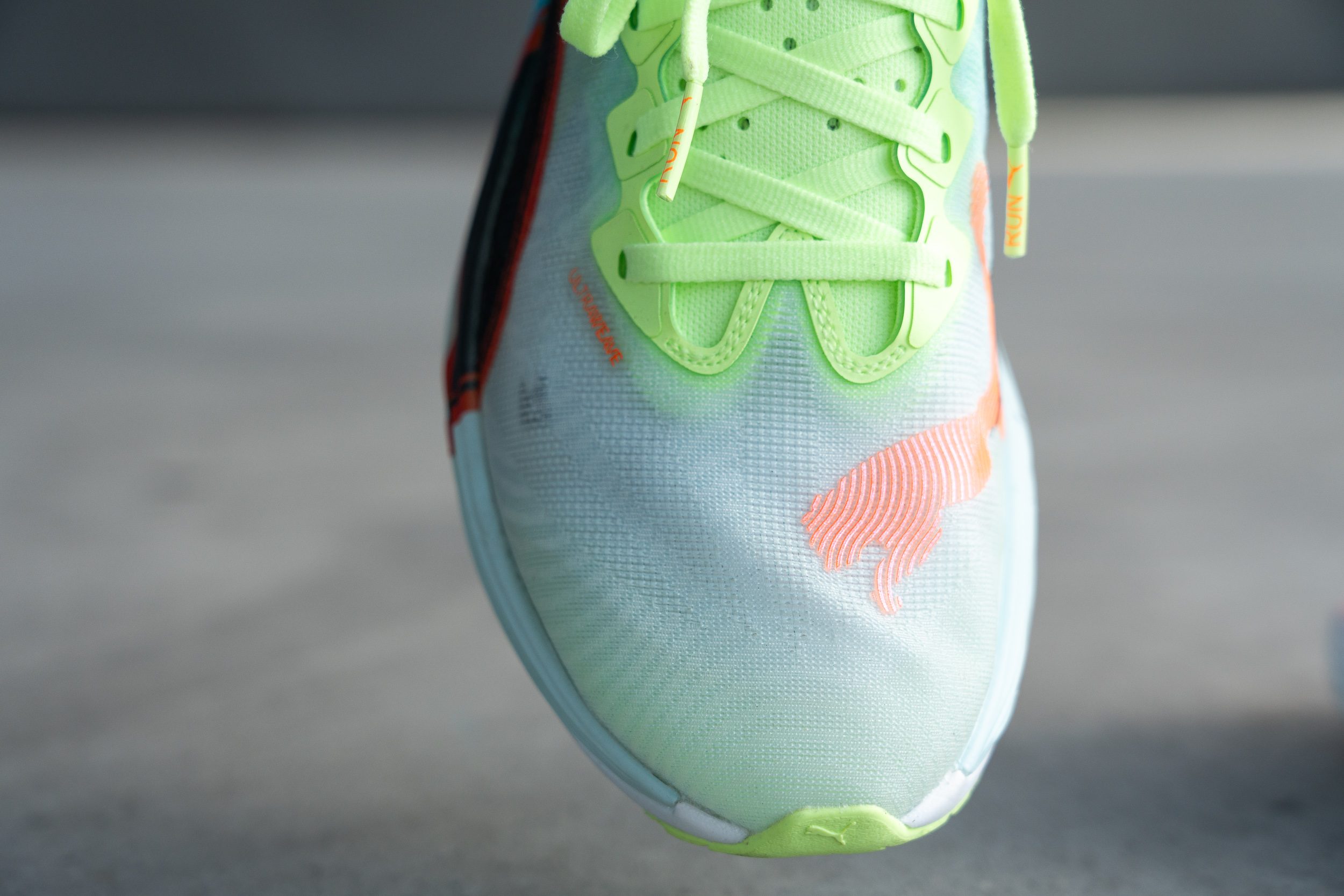
Overall, this is exactly what we anticipate from a modern marathon shoe: well-ventilated, even at the heel, where those holes add a premium touch. Despite the minimal padding, we found it to be more substantial than in other super shoes.
| Deviate Nitro Elite 3 | 4 |
| Average | 3.7 |
Stability
Lateral stability test
This is a fact—the Deviate Nitro Elite 3 is not ideal for runners who prioritise stability in a super shoe. It's a classic, streamlined racer designed for those with solid running form and a neutral stride.
Puma has opted to exclude substantial midsole sidewalls and sole flare, particularly in the heel area, which, despite its high drop, makes this shoe potentially too unstable for rearfoot strikers.
Yet, this lack of stability simply offers a different appeal for a specific group of runners. It's more aggressive, lively, and nimble compared to other super shoes, catering especially to high-cadence individuals tackling shorter, faster distances like 5/10K races.
Torsional rigidity
As you already know, the DNE3 features a stiff carbon plate, and this design delivers exceptional torsional rigidity. During our manual test, we assigned it a max score of 5 out of 5, fully meeting our expectations.
| Deviate Nitro Elite 3 | 5 |
| Average | 3.5 |
Heel counter stiffness
Despite its minimal heel structure, earning a 1/5 stiffness rating, we experienced no heel slippage whatsoever.
Puma adopts a design strategy similar to ASICS' racers—featuring a slightly padded collar that hints at tempo training shoes for a bit more security than ultra-flexible models like the Saucony Endorphin Elite.
| Deviate Nitro Elite 3 | 1 |
| Average | 2.9 |
Midsole width - forefoot
Those seeking a fast, nimble, and agile racer that lives up to Puma's reputation will find it in the Deviate Nitro Elite 3. As mentioned earlier, this shoe isn’t about stability—it’s all about speed and responsiveness. The 108.0-mm measurement we recorded using our digital callipers clearly demonstrates that.
Because of this, while it can handle marathons and perform a great job, we believe it shines brightest in shorter races.
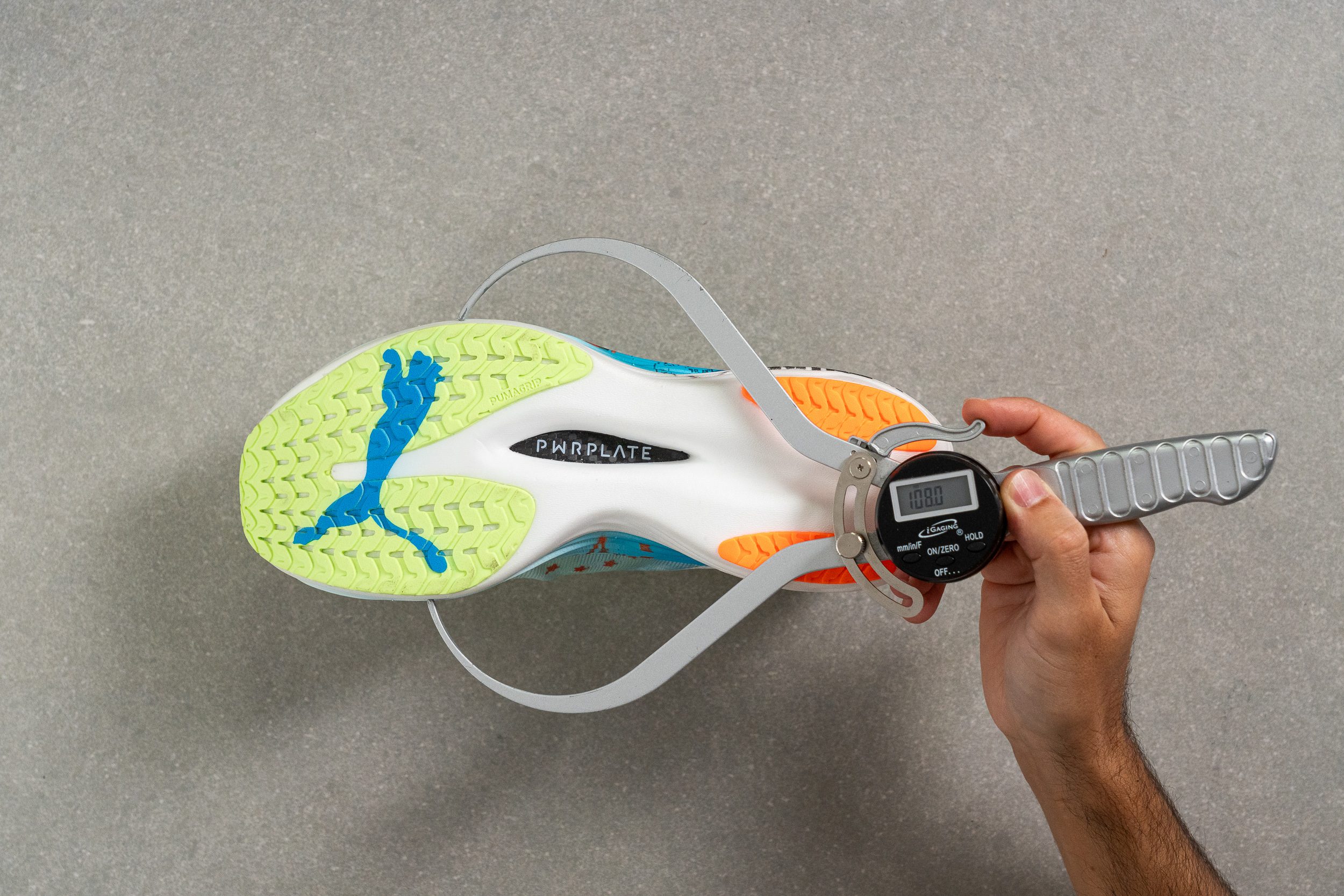
| Deviate Nitro Elite 3 | 108.0 mm |
| Average | 114.4 mm |
Midsole width - heel
The heel's narrow 82.7 mm width, coupled with the absence of stability features, underscores this shoe's suitability for midfoot and forefoot strikers looking for a high-drop racer.
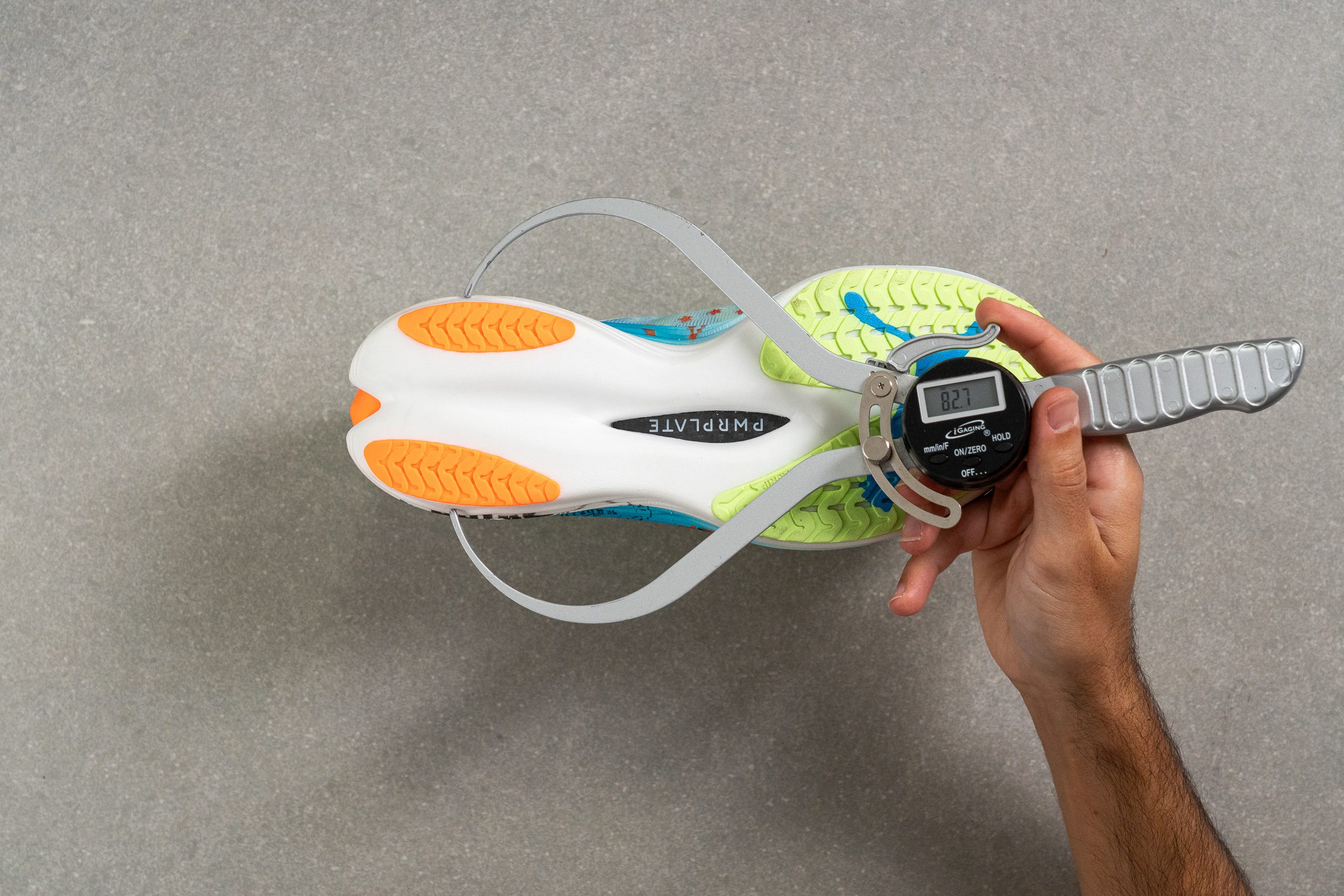
| Deviate Nitro Elite 3 | 82.7 mm |
| Average | 90.7 mm |
Durability
Toebox durability
Regular visitors to RunRepeat might have anticipated our Dremel test results after seeing the microscope images, which showcased the upper's delicate nature.
Indeed, the material proved to be really fragile. We inevitably had to assign it the lowest possible rating.

| Deviate Nitro Elite 3 | 1 |
| Average | 2.6 |
Heel padding durability
The Deviate Nitro Elite 3 turned the tide in our second evaluation with the Dremel tool.
We discovered that the heel counter's lining held up impressively, partly due to the minimal padding in the shoe. Nonetheless, the results were outstanding.
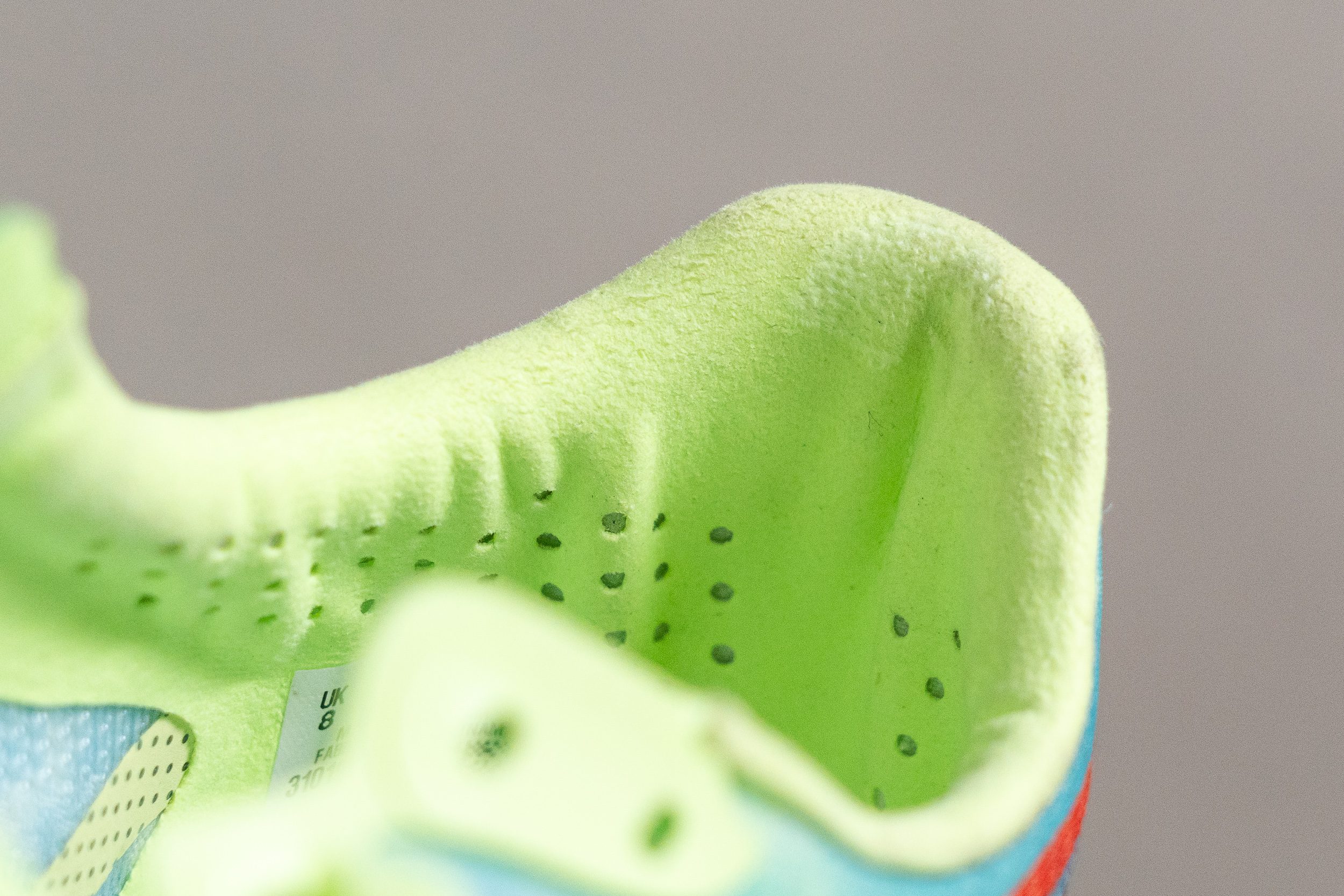
| Deviate Nitro Elite 3 | 5 |
| Average | 3.4 |
Outsole hardness
Let's be clear—we believe PumaGrip is becoming so good it's challenging Continental for the title of best rubber in road running shoes.
For this shoe, Puma opted for a 72.6 HC rubber, aiming for even better grip than their training models by reducing the hardness. It's like a Formula 1 car—the softer the tyre, the better the grip.

And in rainy conditions? Once again, Puma delivers performance that rivals Adidas' Continental. It appears to us there's still a huge rivalry between the two brands founded by the Dassler brothers, each pushing the other to greater innovations.
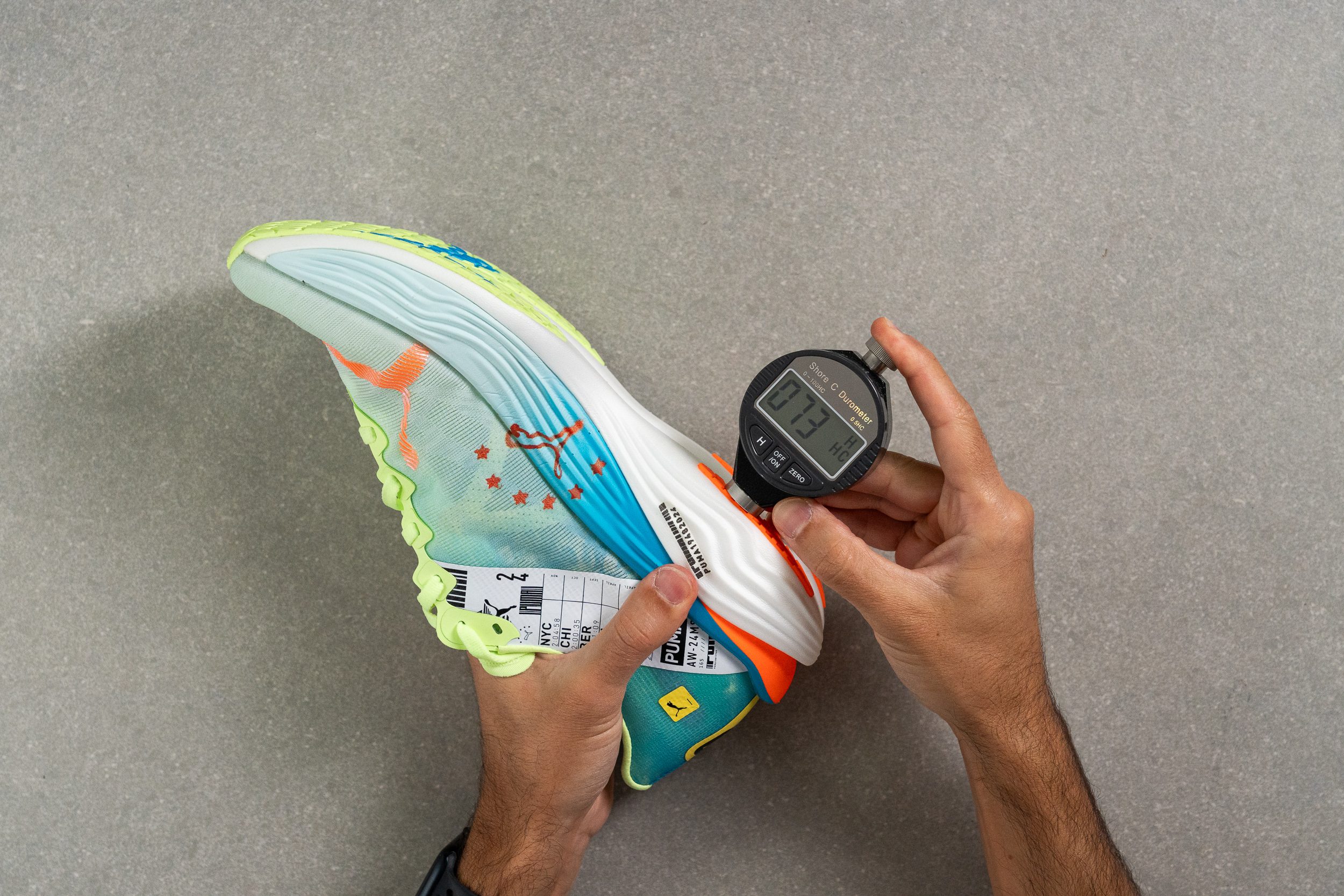
| Deviate Nitro Elite 3 | 72.6 HC |
| Average | 79.2 HC |
Outsole durability
But high grip comes at a cost, as we discovered using our Dremel against the PumaGrip rubber.
While a 20-second test is rigorous, we apply the same challenge to every shoe with consistent force. Afterwards we noted a 1.6-mm dent, more wear than usual but an expected outcome for a grippy super shoe. However, this might make the DNE3 less suitable for tempo training and extended mileage.

| Deviate Nitro Elite 3 | 1.6 mm |
| Average | 1.1 mm |
Outsole thickness
We measured a rubber thickness of 2.6 mm, which should ensure a respectable shelf life for a super shoe despite the rubber wearing out slightly faster than average.

| Deviate Nitro Elite 3 | 2.6 mm |
| Average | 3.2 mm |
Misc
Insole thickness
We discovered the insole typical of a top racer, measuring just 2.8 mm in thickness—a more streamlined option compared to what you'd find in a daily trainer like the Velocity Nitro 3.
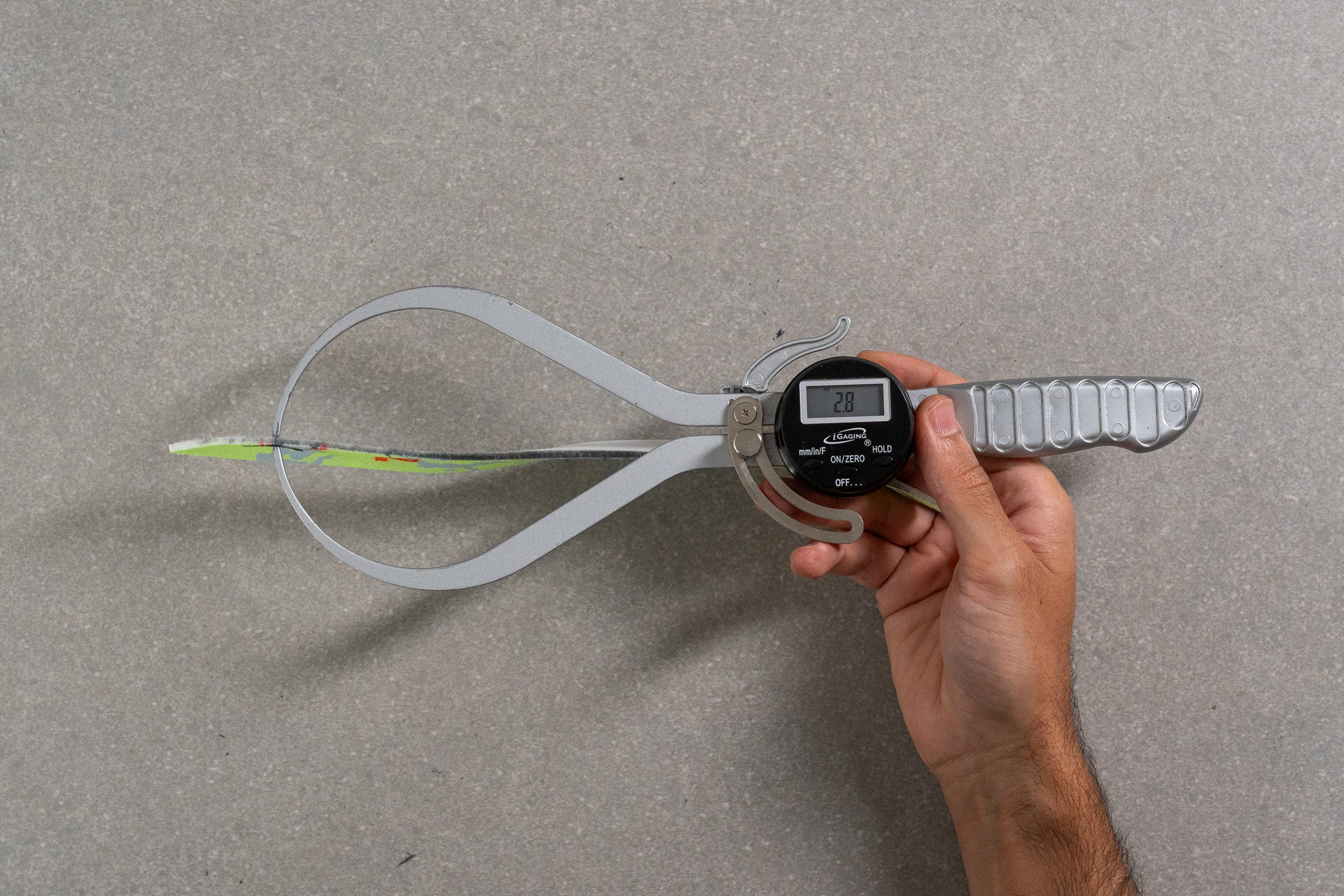
| Deviate Nitro Elite 3 | 2.8 mm |
| Average | 4.5 mm |
Removable insole
Unlike many marathon shoes where the insole is permanently fixed, the Deviate Nitro Elite 3 allows for its removal. You can easily swap it out, although the original insole is so cool that we prefer to keep it as is!
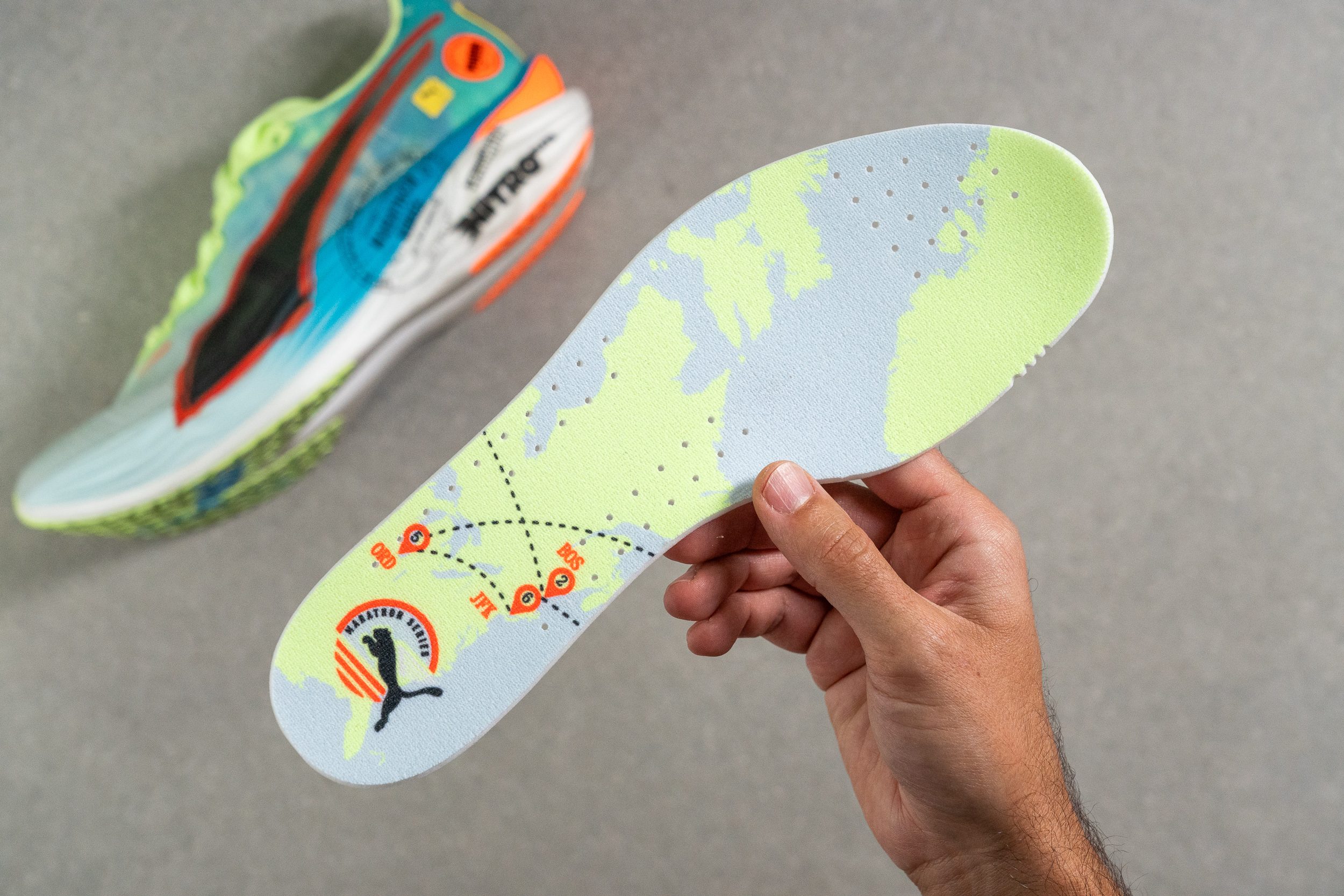
| Deviate Nitro Elite 3 | Yes |
Midsole softness in cold (%)
While the A-TPU Nitro Elite foam offers several advancements over traditional PEBA-based materials, it falls short in cold temperature performance. Our freezer test revealed a disappointing 25.8% uptick, which fell below our expectations.
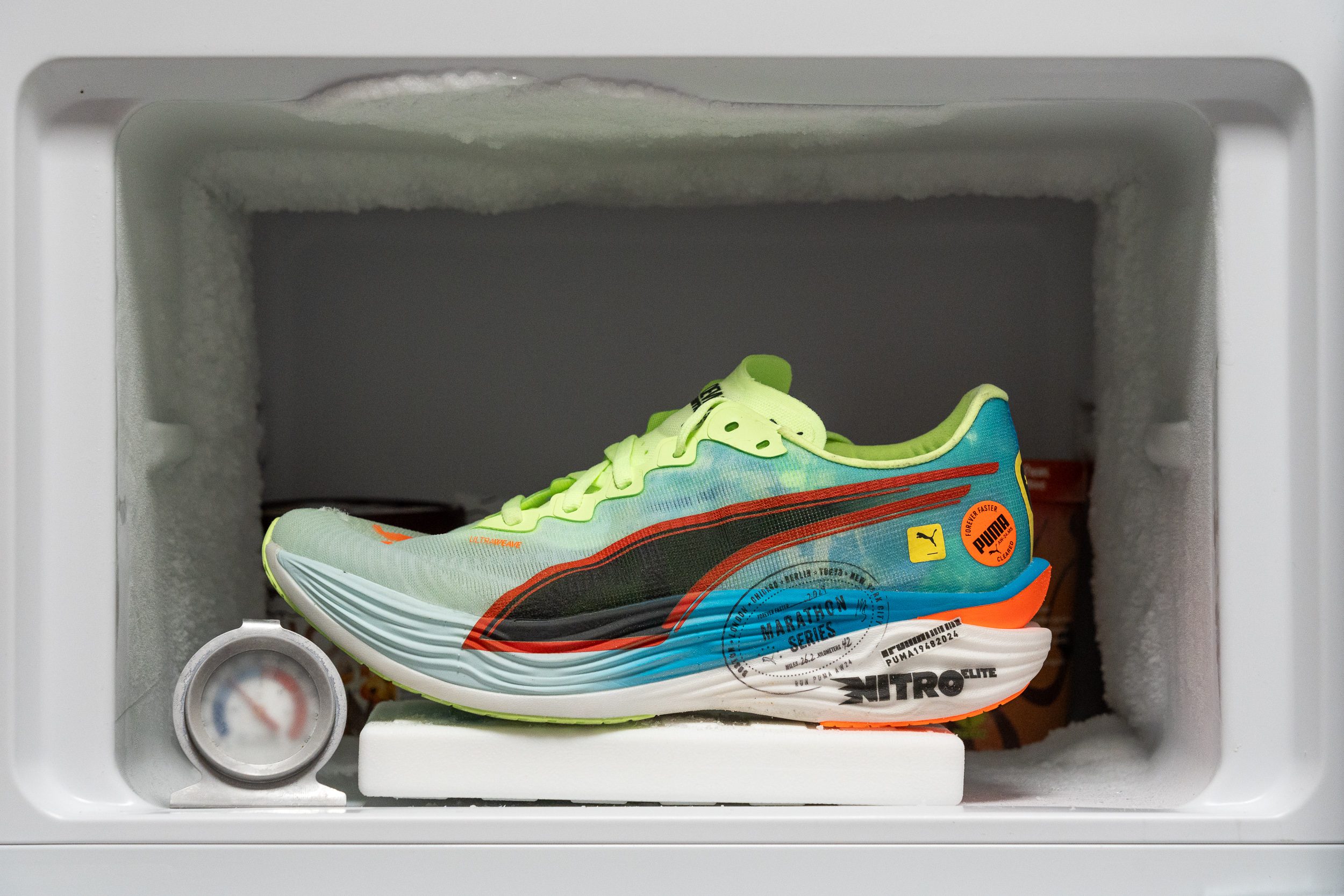
| Deviate Nitro Elite 3 | 26% |
| Average | 24% |
Reflective elements
This colorway is so unique that we expected some reflective details, but it seems Puma let us down here. In our view, adding reflective elements would have made this shoe even better for low-light tempo workouts!

| Deviate Nitro Elite 3 | No |
Tongue padding
Most road running shoes without a gusseted tongue typically feature a single loop to prevent shifting, but Puma has introduced a dual-loop, parallel design in this shoe. And it works amazing.
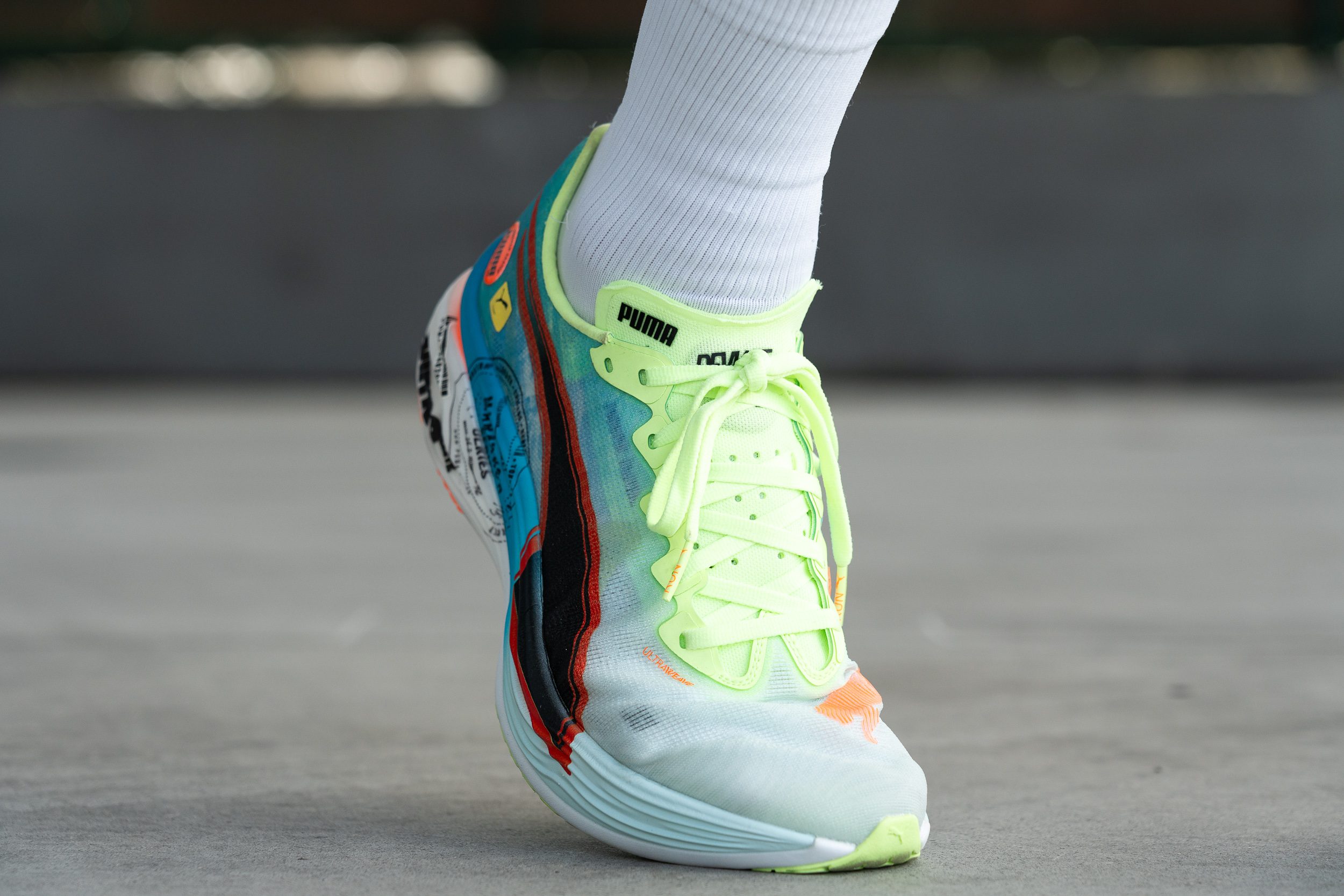
We were also impressed by the intelligent padding on the tongue. Unlike most racing shoes that have minimal padding, Puma cleverly combines a sleek, paper-thin tongue with a concentrated cushion right where the laces tighten, achieving an ideal balance of comfort and lightness.
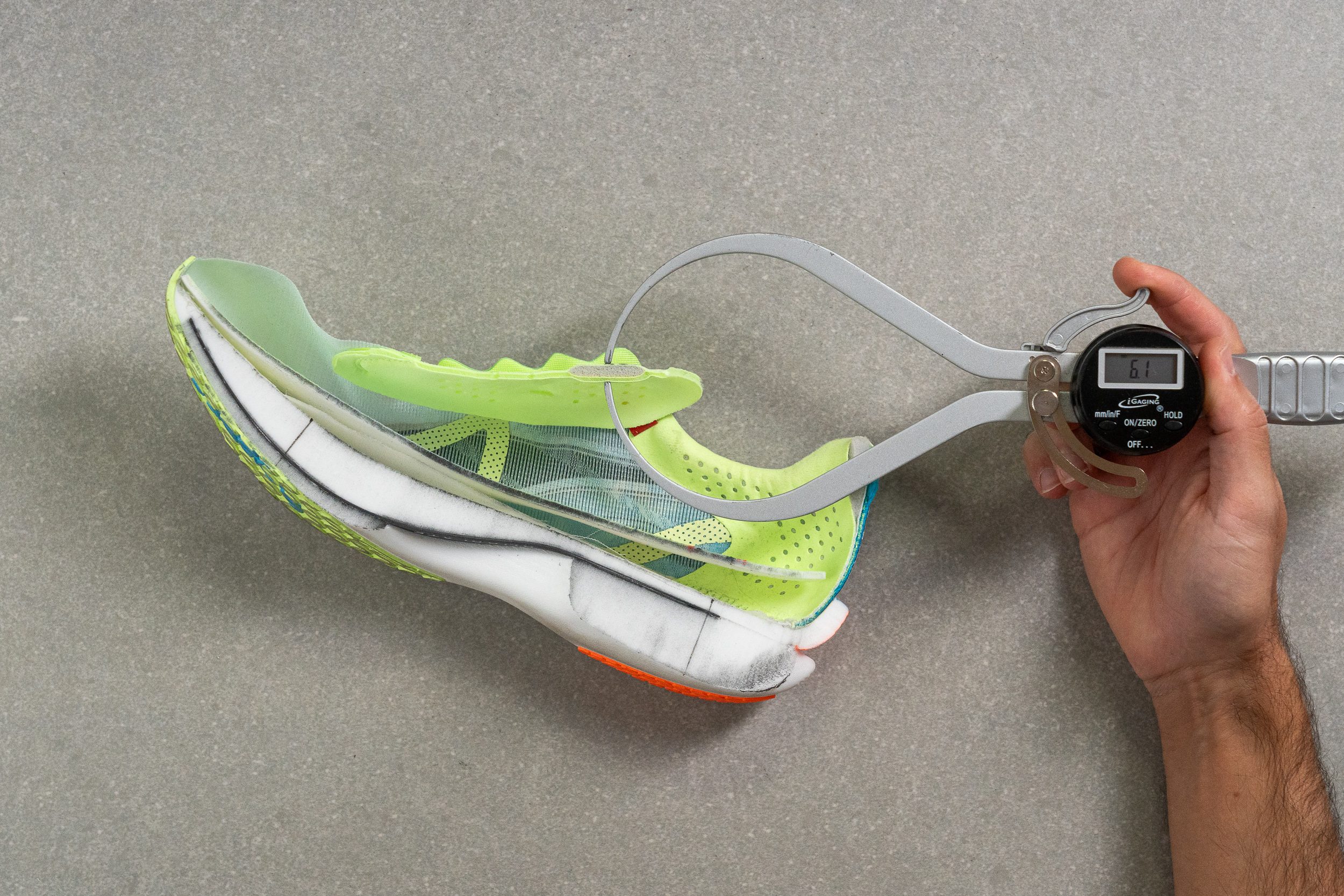
| Deviate Nitro Elite 3 | 6.1 mm |
| Average | 5.8 mm |
Tongue: gusset type
We observed that the tongue is not fixed to the sides, which might seem unexpected in a high-end shoe. However, this feature is standard in super shoes, specifically designed to minimise weight for optimal performance.
Additionally, it's important to note that this non-gusseted design significantly improves ventilation, particularly in the medial area, ensuring enhanced breathability during races.

| Deviate Nitro Elite 3 | None |
Price
While running shoe prices have generally increased, the Puma Deviate Nitro Elite 3 offers a delightful exception.
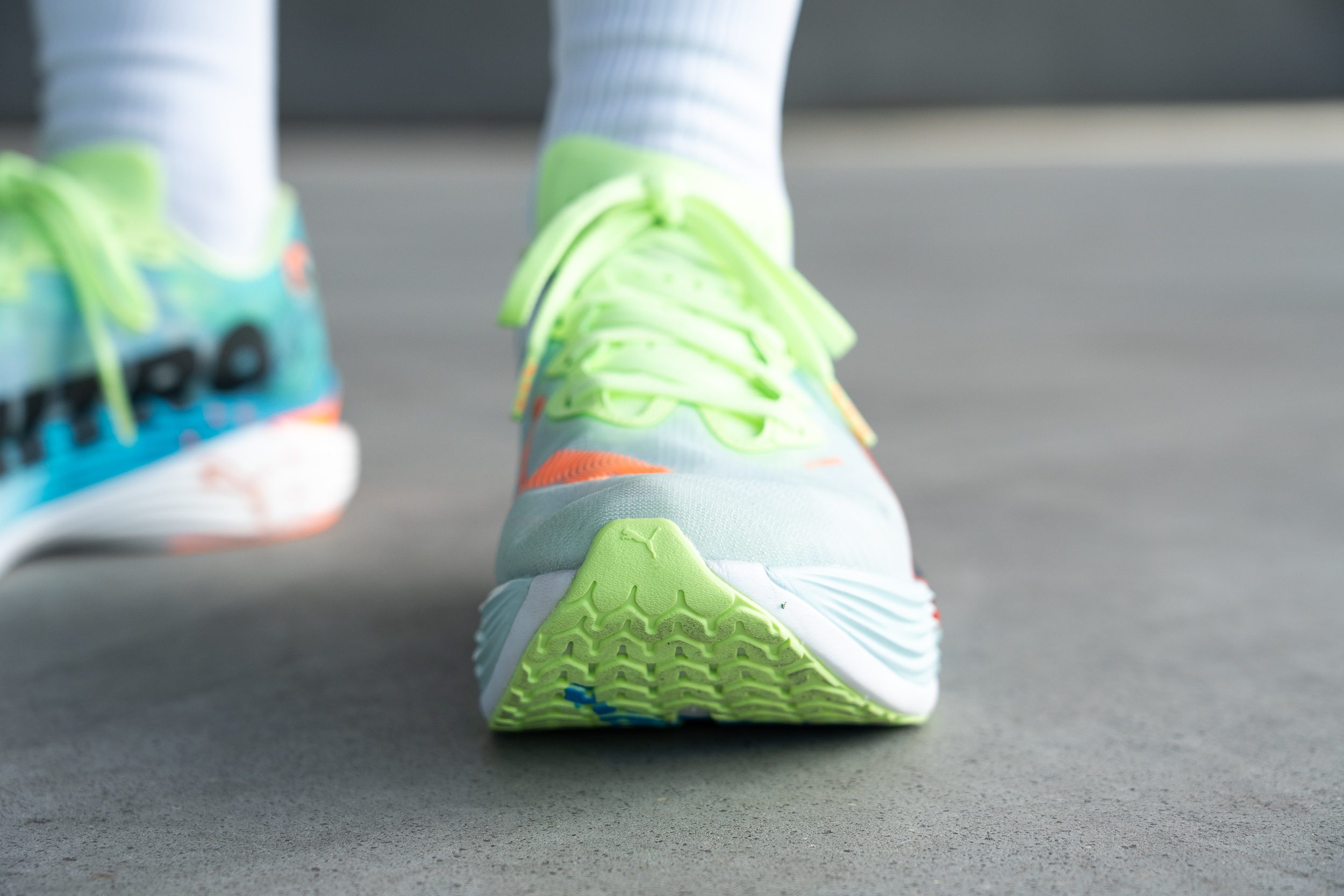
Despite surpassing the £200 mark, it remains one of the most budget-friendly racing shoes. Let's not forget that this model impressively combines a lightweight design, a carbon plate, and a second-to-none superfoam!
| Deviate Nitro Elite 3 | $230 |
Heel tab
PUMA has retained the same heel design from previous models, omitting the heel tab. While this design choice makes the shoe slightly more challenging to put on, it remains one of the easiest super shoes to slip into quickly, also making it a practical option for triathlons.

By the way, congrats to Puma for putting out this AW24 Major Marathons colorway. They even showcased the current records—including Kiptum's 2:00:35—despite none of them being set by Puma athletes.
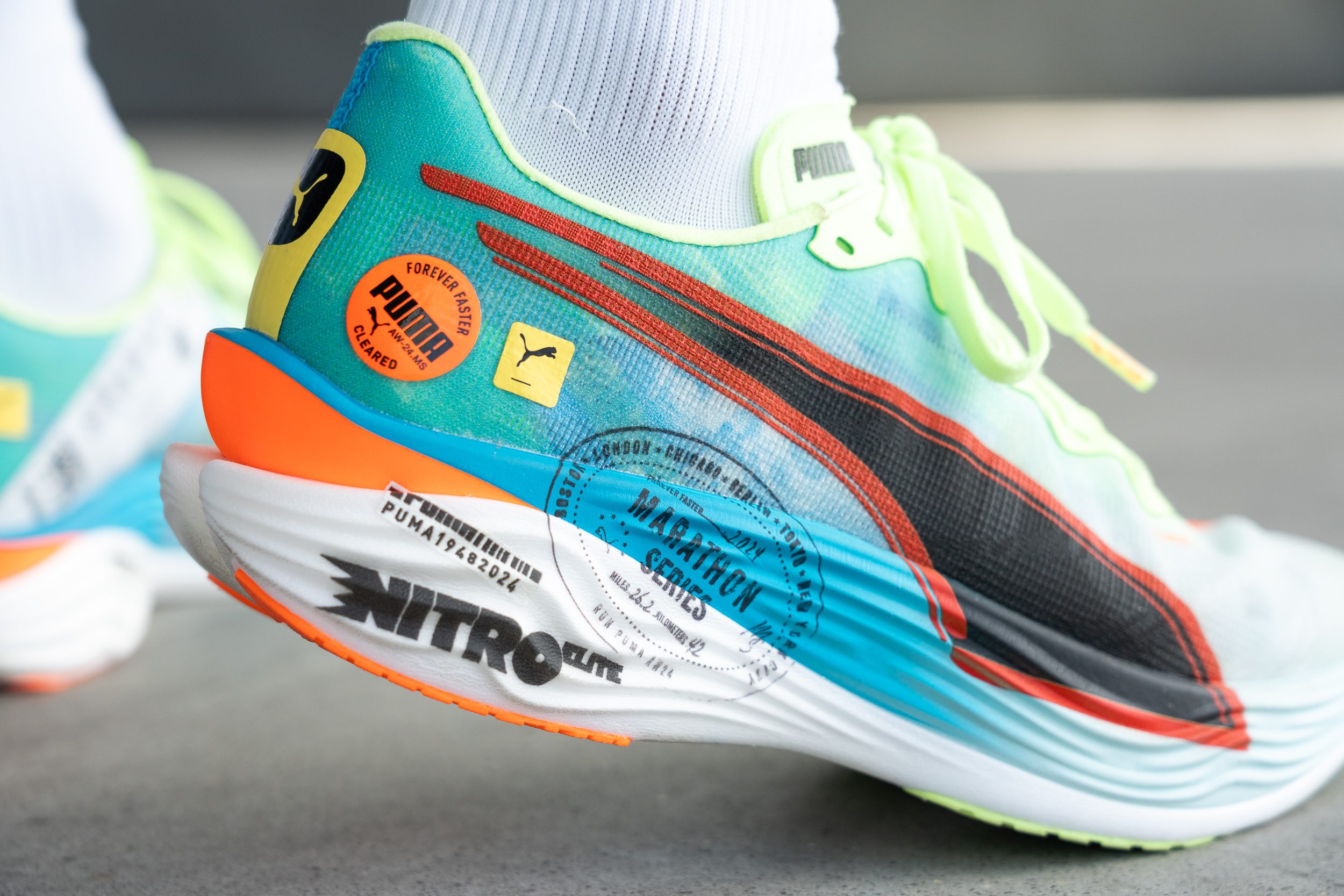
| Deviate Nitro Elite 3 | None |

